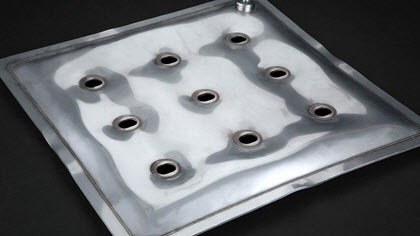Electron Beam Welding vs. Laser Beam Welding
Electron beam welding and laser beam welding are both fusion welding techniques that use a high energy density beam to melt the joint of two components. Advantages to these two technologies include versatility, high power, automatability, and high weld quality.
However, these two methods of welding are incredibly different, and understanding their differences helps us make a decision about which method to choose. In the competition of electron beam welding vs. laser beam welding, who comes out the winner?
Laser Beam Welding
 Laser beam welding works by rapidly raising and lowering the energy state of a material, which causes the emission of photons. These photons are concentrated, made coherent, and then projected. This rapid heating allows for a shorter beam interaction time versus other traditional welding methods, resulting in a smaller heat-affected zone and the ability to weld smaller parts without affecting nearby areas.
Laser beam welding works by rapidly raising and lowering the energy state of a material, which causes the emission of photons. These photons are concentrated, made coherent, and then projected. This rapid heating allows for a shorter beam interaction time versus other traditional welding methods, resulting in a smaller heat-affected zone and the ability to weld smaller parts without affecting nearby areas.
A laser welding system can deliver energy very quickly. The beam can be focused and reflected to target hard-to-access welds, and it can be sent down a fiber-optic cable to provide even more control and versatility. This process can achieve good penetration, usually up to about 0.040 inches deep in steel, and can join crack-prone materials and dissimilar materials.
Pros
- Lower cost to setup than electron beam welding
- Can weld virtually any size component
- Short cycle times
- Simple tooling requirements
- Minimal heat-affected zone
- No x-rays generated by the process
- Able to easily automate
- Faster weld speed than arc welding
- Lower heat input and less distortion than arc welding
- Can weld in air
Cons
- Gas contamination is possible
- Smaller weld penetration than electron beam welding
- Often requires post-weld machining or heat treating
Electron Beam Welding
With electron beam welding, an electron beam can be very accurately placed and much of the original strength of the material is maintained. This results in a high-quality weld.
In this process, a tungsten filament is heated causing it to give off electrons. These electrons are accelerated and focused into an invisible stream of fast-moving electrons. When these electrons strike a metal part, it is heated almost instantly. The ultra-high energy electron beam allows for deep penetration and high aspect ratios, along with the smallest heat-affected zone possible. A typical high-voltage electron beam welding machine can produce a weld in steel 2 inches deep.
However, the logistics of operating an electron beam welding system aren’t simple. The process must happen in a vacuum to prevent air/gas particles from scattering and diffusing the electrons. The size of the part to be welded is limited by the size of the required vacuum chamber. The larger the chamber, the longer it will take to establish the necessary vacuum level, bogging down the welding process. The electron beam has to be carefully calibrated and focused and time with the CNC motion to deliver a consistent weld with uniform penetration and minimal porosity. All of this requires well-trained operators, very thorough maintenance, and – frequently – a good deal more time than laser beam welding. Additionally, the setup and running of the electron beam welding system are expensive; a cost that is passed down to the customer.
Pros
- No gas contamination
- Deepest weld penetration
- A clean welding environment is guaranteed
- Small heat-affected zone
- No additional processing required
Cons
- High initial setup cost due to vacuum enclosure
- Size is restricted by the vacuum chamber
- Longer cycle times than laser beam welding
- Often requires complex tooling
- X-rays generated during welding
- Requires careful design consideration to achieve desired results
- Decision Points
At Superior Joining Technologies, Inc., we choose laser beam welding for a variety of reasons.
- Laser beam welding respects our customer’s cost and delivery goals.
- Laser beam welding parts are easier to tool and fixture.
- Laser bean welding allows for pinpoint accuracy without sacrificing production rates.
- Laser bean welding does not restrict the size of the part being welded.
- Laser beam welding is an excellent way to join thin materials and extremely small components.
- Laser beam welding offers shorter cycle times which lowers overall costs without sacrificing quality.
Laser beam welding works with a large variety of materials:
- Copper
- Steel
- Stainless steel
- Brass
- Silver
- Gold
- Platinum
- Carbon steel
- Aluminum
- Titanium
- Low alloy steel
- Nickel
- Molybdenum
- Kovar
Why Choose Superior Joining Technologies, Inc?
At Superior Joining, we have years of experience and technical expertise using laser beams to weld a large variety of components. We produce a professionally finished product time after time. We work with the following industries to provide laser beam welding services:
- Aerospace
- Defense
- Industrial
- Maritime
- Medical
- Nuclear
- More
Superior Joining Technologies, Inc, is a woman-owned small business that is ITAR Registered, an FAA Repair Station, Federal Firearms Licensed (FLL) Facility, accredited by Nadcap, AS9100, and ISO9001.
Our staff offers high-quality laser beam welding services and works with each of our customers to make sure that we’re using our expertise in a way that delivers the best possible solution to each customer’s unique design specifications.






